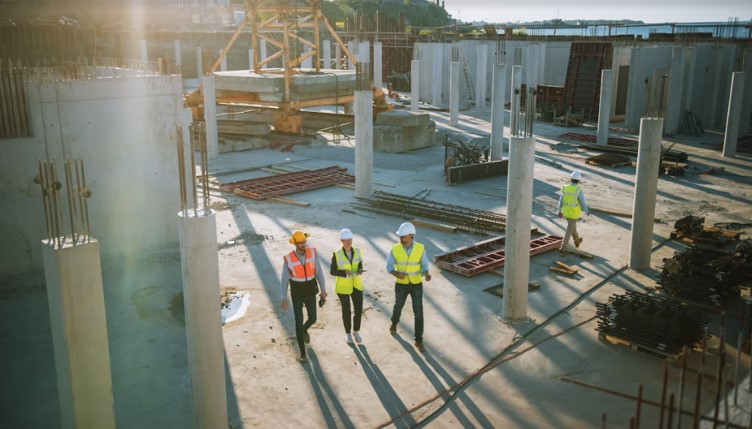How To Keep Construction Projects Safe And Efficient?

A construction project is any building or renovation process conducted by a group with specific goals. It could be for residential, commercial buildings, roads, or other infrastructure.
The scope of these construction projects may be simple and require only aesthetic adjustments. Conversely, it can also be complex, requiring multiple stages over months. Regardless of the circumstances, all these projects have one thing in common; they need planning to ensure the construction process is safe and successful.
For example, the construction site can often be overcrowded with equipment and building materials. Such clutter increases the risk of accidents, such as tripping, which could cause injuries. You can avoid this situation by organizing all building materials in bulk bags and placing the carriers in the store. Consider labeling the bags so it’s easy to pick out what you want during construction. This helps streamline the building process. This is only one example among an infinity of dangerous scenarios in a construction site. If you’re ever injured while working on a construction site, it’s essential to speak to a construction accident attorney to help you determine what to do next. Some lawyers offer free consultations and can guide you, ensuring you receive the compensation you deserve. However, the best way to prevent accidents is by taking the appropriate precautions.
Keep reading to learn more steps to ensure safety during a construction project.
Overview Of Safety And Efficiency
In the construction industry, safety must always come first. Having procedures and regulations set out beforehand helps reduce the chances of injuries. Likewise, the time invested in a building is equally significant. Given the labor costs and materials associated with each task, this process requires comprehensive organization.
Here are some of the steps you can take to organize your construction project process better.
Step One: Plan Ahead
The first step is planning what must be done before you begin onsite work. You can do this by following this checklist:
- Allocate resources, such as labor, materials, and tools.
- Schedule activities effectively by considering things like weather conditions or access restrictions.
- Design an adequate workplace layout that considers health and safety regulations.
- Create standard operating procedures (SOPs) detailing how to accomplish each task safely.
- Conduct risk assessments before starting any activity.
Doing these measures in advance would be best to avoid unpleasant surprises once construction begins. This way, you can prevent delays or potential dangers to workers’ well-being.
Step Two: Organize The Site
Keeping an orderly workplace is crucial for preventing slip-ups. Removing needless clutter from the workplace is another benefit of site organization. This may improve the working environment and encourage workers to be more productive.
Furthermore, when you have all the materials and tools organized, you can keep up with your inventory and reduce the potential for theft. Also, should there be any remaining building materials, you can use them for future repairs.
Therefore, consider investing in containers, shelves, racks, and adequately labeled bulk bags for the most efficient storage. Provide safe places to put tools and a clear system of walkways and access points.
This will keep all necessary construction supplies organized and within easy reach of workers without compromising safety protocols.
Step Three: Document Each Stage
A project’s documentation is only as reliable as the records it keeps. Therefore, it’s best to document all the necessary steps for your construction project. For instance, you may be asked to provide evidence of an Environmental Impact Assessment (EIA). By documenting every file early on, you can quickly find the files you need to provide proof of compliance. Remember that compliance demonstrates that you value quality and safety during construction.
Similarly, proper record-keeping creates a good reference point for future similar projects. This helps in better and more seamless execution.
Step Four: Invest In Proper Equipment
Having the correct type of equipment is essential for any construction project to be completed safely and efficiently. Investing in quality tools, machines, scaffolding, and ladders can help reduce workplace injuries. It also helps get the job done quickly.
It’s vital to ensure all equipment has been tested before use. This has to be done by qualified personnel who can certify their operation according to industry standards. Doing this helps reduce risks associated with using malfunctioning tools and machines.
In addition, personal protective gear such as hard hats and steel-toe boots must always be worn when operating machinery.
Step Five: Use The Latest Technology Onsite
Using advanced technologies such as drones, GPS tracking systems have become more common in the construction industry. These technologies offer multiple benefits, such as mapping out areas accurately and monitoring progress remotely.
For example, cameras and other devices are set up at various vantage points around site boundaries. This helps identify problematic spots faster than humanly possible, saving time and money resources. These tools also reinforce a commitment to ensuring the highest efficiency and safety. Employees can stay one step ahead and proactively address potential risks when identified early.
Step Six: Report Issues Immediately
You must report any issues or accidents occurring on a construction site immediately. All relevant details about the incident, including time and date, location, and witnesses present, have to be recorded,
It’ll enable an in-depth investigation into what went wrong and how you could have prevented it. Keep in mind that reporting this could prevent further injury to employees.
Step Seven: Ensure Quality Control
This step is essential for ensuring the successful completion of a project since it ensures that everything meets or exceeds standards set by regulatory bodies or client specifications. It includes regular inspections throughout the process to identify potential issues that may have been left unchecked.
In addition, this step also helps identify areas where further resources are necessary to complete tasks within given constraints. Note that quality assurance tests should go on throughout each project phase. It’s essential to quickly identify and rectify problems before they become severe and even delay completion.
Step Eight: Communication And Collaboration
Good communication is an integral part of ensuring a successful construction project. This includes the project manager, contractors, suppliers, and other personnel involved. It’s crucial to keep everyone updated on developments and the status of any problems that may arise. Likewise, ensure that all parties work together collaboratively to ensure swift progress.
Step Nine: Ensure Adequate Supervision And Training
The right direction and personnel education are crucial in keeping a construction project safe and efficient. It means having enough qualified supervisors with relevant experience who know how to oversee onsite activities properly:
- Make sure all personnel involved understand what their roles and responsibilities entail.
- Ensure everyone knows how to work safely without putting themselves at risk of injury.
- Train at regular intervals using manufacturer guidance provided with each equipment purchase.
- Conduct regular audits or inspections throughout the process of building.
Proper training ensures that everyone knows the safety tips when working. It also helps workers learn how to use the technology and construction equipment for maximum benefit without compromising safety.
Step Twelve: Do Post-Project Wrap Up
Finally, once a construction job has been completed successfully, the teams involved must conduct an analysis. They should reflect on what went well, the difficulties encountered, and proposed solutions. Insights such as this are invaluable for enhancing the success of future endeavors.
Conclusion
Construction projects require careful planning and organization from start to finish to ensure safety and efficiency are maintained. When adopted or followed, the above steps will go a long way. The desired result is achieved, and satisfaction is guaranteed for stakeholders and customers alike.
Additional:

























Leave A Reply